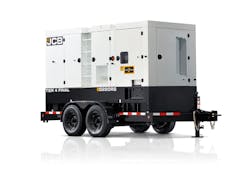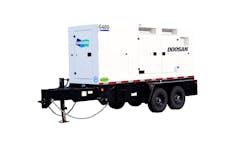Technology Supercharges Generators
Telematics, paralleling, and load-management systems, for example, now provide managers with enhanced efficiency with mobile generators.
Paralleling allows users to harness wattage they otherwise couldn’t, and bid on more jobs because of it. A parallel management system (PMS) connects low-watt generators (around 100kW) to create a greater power source. Sites without access to high-watt generators (around 300kW or more) are primary users.
According to Eric Massinon, business development manager at Chicago Pneumatic, paralleling generators used to be controlled through a manual switchboard. In the event of a failure, operators had to manually replace the failed generator.
Today, touchscreen controllers automatically control generators based on the power required (the ideal load should be between 60 and 80 percent). Users connect the appropriate number of generators together before the job begins—including backup generators. The PMS will switch them on and off as needed.
“If there was a failure, the controller would start a third generator and put it online immediately,” Massinon says. “With PMS, it’s done without operator interference. So now you have a generator down, but you have time to react and get it fixed.”
According to Massinon, generators running electric motors can require six times more power to startup a job than they do for continuous operation. Since varying power demands can place generators in a state of under loading, the PMS also controls power use afterward.
For example, if a job requires three 300kW generators at startup, Massinon says it may only require 100kW or less to continue powering the site. In this case, the system would automatically turn one generator off to prevent under loading.
The PMS will also equalize all paralleling-generator loads by hours.
“The PMS will shut down and stagger startups to spread the hours out across all three machines,” Massinon says. “It will do that on its own while keeping the best possible load on the generators.”
Rental companies can use PMS to field its smaller generators to provide the power necessary to do jobs that normally would require the acquisition of a larger gen set. The setup also saves fuel.
“If you’re running a 400-horsepower generator under 30 percent load, you still have a lot more engine running, so it uses more fuel,” Massinon says. “If you use three 157-horsepower generators at 60 percent load instead, they’re going to use a lot less horsepower and therefore a lot less fuel. So the fuel savings to the end user will immediately start adding up.”
Load-management enhances generator efficiency
Load-management technology also enhances generator efficiency. Doosan Portable Power’s Intelligent Load Management System (ILMS), for example, is designed to reduce “wet stacking,” or unburned fuel passing into the exhaust system.
Wet stacking occurs when a generator operates under too light of a load. Piston rings are unable to expand properly in the engine cylinder, allowing oil to begin stacking on top of the piston.
“Especially in cold weather at low load, you get a lot of unburned particles,” says Travis George, Doosan Portable Power product manager. “In a diesel engine, this material will build up and damage exhaust components.”
If a customer uses a 50kW generator on a 15kW job, for example, the system forces the generator to operate a full load to burn off the accumulated build-up.
“Proper heat exhaust temperature is the condition necessary to avoid wet stacking,” says David Murphy, market solutions manager at Generac. “Proper loading is the catalyst generating heat.”
To do this, the ILMS transfers hot water into the generator’s jacket system to raise it to operating temperature. This allows excess oil to pass through the exhaust system.
“The more heat within the engine and exhaust, the better,” says George. “It helps the Tier 4-F engines run much smoother under those conditions.”
The ILMS system adjusts exhaust temperature regardless of load demands, according to George. It requires no operator monitoring.
“We’ve had several customers running generators in colder parts of the U.S.,” he says. “At certain times in the day, they’re using very little power. In that case, ILMS would prevent them from running at low load.”
To manage load in its engines, John Deere utilizes an exhaust temperature management system (ETM). Generac uses Deere’s engines to power some of its mobile generators.
If unburned fuel reaches the exhaust system, the ETM senses the low exhaust gas temperature and restricts flow by closing internal valves.
“They close just enough to raise the temperature and burn off any diesel fuel or particulate that’s gotten through,” says Murphy. “It has no effect on the load.”
According to Michael Dunning, regional sales manager at Allmand Global, its ETM system provides customers with better reliability and up to 40 percent lower fuel consumption.
“It provides customers with generator longevity due to not having unnecessary loads put on it,” he says.
If left untreated, wet-stacking repairs can cost anywhere from $12,000 to $18,000, Murphy says.
“Servicing might take hours of a technician’s time whereas with ILMS, it prevents low-loading from occurring altogether,” says George. “You don’t have to touch the generator.”
How telematics aids generator performance
Machine data provided by mobile generators has given users additional ways to monitor and maximize performance. In many cases, managers can access telematics in real-time. According to George, having the ability to view engine data in real-time is a huge asset-management benefit.
In the event of a failure, telematics offer users better service efficiency. Instead of sending a technician to diagnose an issue, systems like Atlas Copco’s FleetLink immediately alert users of the problem.
“Now the technician can drive to the generator with a spare part and fix it, which is a huge improvement,” says Angel Nieto, product manager of power and light at Atlas Copco. “In addition, total cost of ownership reduces because you know exactly when you need to service your generator.”
FleetLink also features geofencing. If a generator is moved without authorization, users are notified.
“If someone is taking the generator, you will get a message telling you the machine is moving out of its specified location,” says Nieto. “That’s why telematics are especially important in the mobile power generation business. Having the ability to ‘be there’ virtually is a big benefit.”
Telematics also can inform users of efficiency trends. For example, a review of historical data may show a generator is operating under load. In this case, a different sized generator will provide more appropriate power output.
“Oversizing happens a lot with rental companies,” Nieto says. “A customer won’t know the power they need, and instead of a 100kW generator, they’ll ask for 200kW. Now companies can better advise their customers with tracked load levels.”
JCB’s LiveLink also helps users identify imbalanced loads, enabling the user to take corrective action using information viewed remotely.
In one instance, globally compiled LiveLink data concluded that the majority of JCB generators were running at less than 30 percent of their rated load. This number is important when operating Tier-4 equipment, according to Lee Jaquiss, JCB’s general manager for power products.
“An engine can be damaged from as little as 600 hours of light loading,” Jaquiss says. “Replacement costs, depending on size, could be between $1,000 and $4,000.”
Determining the best sized generator for a given job beforehand prevents potential downtime.
“Not trying to oversell from a capacity standpoint, and making a point to right-size a product, is better for maintenance and the unit,” says Jim Rummel, associate director of marketing at Kohler. “It’ll cost you less to run, and is more efficient.”
As for the future of the mobile generator segment, manufacturers expect to see more connected machines.
“The use of telematics within the power generation industry, specifically rental, are definitely growing and will continue to grow,” Jaquiss says. “The control platforms and data will become increasingly more in depth and intelligent.”




